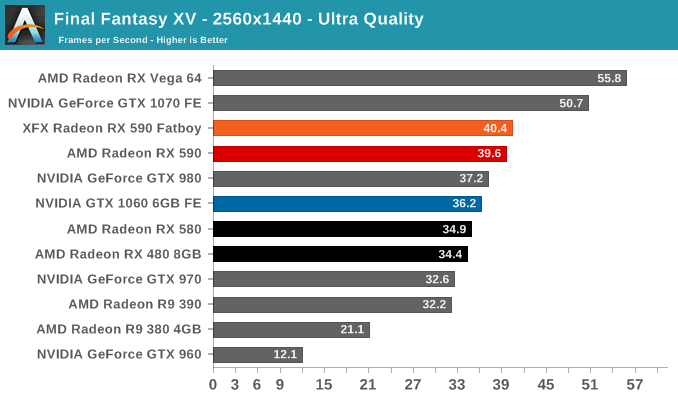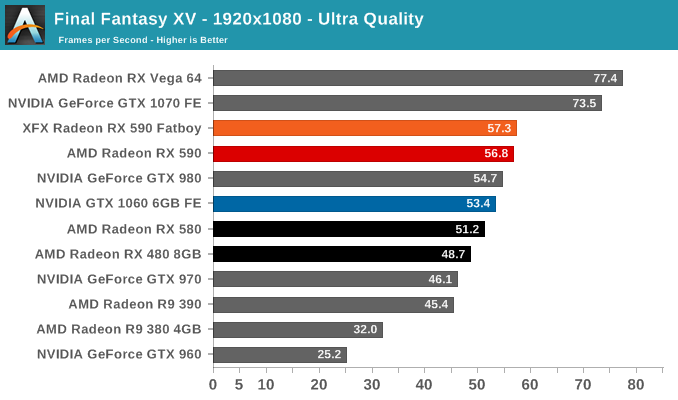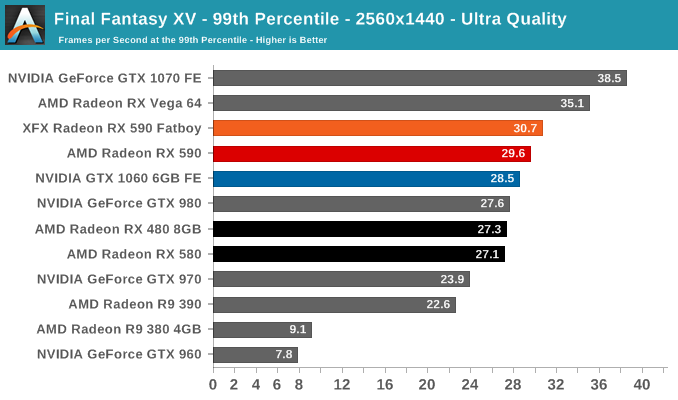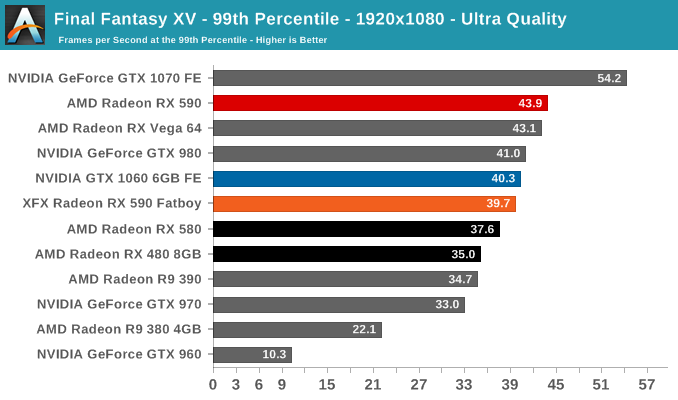The AMD Radeon RX 590 Review, feat. XFX & PowerColor: Polaris Returns (Again)
by Nate Oh on November 15, 2018 9:00 AM ESTFinal Fantasy XV (DX11)
Upon arriving to PC earlier this, Final Fantasy XV: Windows Edition was given a graphical overhaul as it was ported over from console, fruits of their successful partnership with NVIDIA, with hardly any hint of the troubles during Final Fantasy XV's original production and development.
In preparation for the launch, Square Enix opted to release a standalone benchmark that they have since updated. Using the Final Fantasy XV standalone benchmark gives us a lengthy standardized sequence to utilize OCAT. Upon release, the standalone benchmark received criticism for performance issues and general bugginess, as well as confusing graphical presets and performance measurement by 'score'. In its original iteration, the graphical settings could not be adjusted, leaving the user to the presets that were tied to resolution and hidden settings such as GameWorks features.
Since then, Square Enix has patched the benchmark with custom graphics settings and bugfixes to be much more accurate in profiling in-game performance and graphical options, though leaving the 'score' measurement. For our testing, we enable or adjust settings to the highest except for NVIDIA-specific features and 'Model LOD', the latter of which is left at standard. Final Fantasy XV also supports HDR, and it will support DLSS at some later date.


For Final Fantasy XV, the older R9 380 and GTX 960 simply can't keep up with the demands and are essentially unplayable with particularly low 99th percentiles. VRAM wouldn't be the sole issue - though FFXV does use high resolution textures - as the GTX 980 (4GB) performs up to par. NVIDIA hardware tends to perform well on FFXV but as with Ashes: Escalation, the RX 590's extra performance permits it to claim victory, reference-to-reference, which the RX 580 was unable to do here.













136 Comments
View All Comments
Kriswithak - Thursday, November 15, 2018 - link
I would love to see if the improved process offers better efficiency.With the RX480 4gb, I undervolted the card and saw a significant decrease in load power consumption.
With the RX580 8gb, I dropped the boost clocks a bit and dropped the voltage as well, and only used 6 pin power connector.
I would like to see the rx590/580/480 at similar reference/boost clocks, then undervolted to lowest possible stable and see what the frame per watt comparison is.
Nfarce - Thursday, November 15, 2018 - link
Just another example of AMD shooting their R&D wad at the APU/CPU segment and ignoring the GPU segment. There is ZERO reason to buy this fail over Nivdia unless you have already bought a Freesync monitor and a much older AMD GPU, which monitors, by the way, do work with Nvidia GPUs when locking down the v-sync tool. I have a Freesync 75Hz monitor ( 32" 1440p AOC) and love it with my GTX 1070 Ti locking in frames (bought it for $369 on NewEgg in a promo sale). Said 1070 Ti doesn't even need to breathe hard. Minimum FPS never comes close to hitting 75 FPS. Not only is it 30+% faster, but it also consumes nearly 20% less power under load than this card. Yeah, that's worth the extra $80 for my 1070 Ti in my book. You get what you pay for. I really hope AMD starts using some of their Ryzen revenue that they've been taking in for - nearly three years now mind you and not including their revenue stream from game console APUs - into upping their dedicated GPU game. Because they have a long way to go to match Nvidia in the upper tiers where the real price margin revenue is made. Nobody makes money on low and mid range GPUs where AMD has always targeted.eva02langley - Friday, November 16, 2018 - link
You are missing the point here, Lisa Su said that decision are took 3-5 years in advance for their roadmap.Polaris was already a thing and just making a 12 nm was an easy thing to do and was filling a gap.
People tend to forget that the 8GB RX 580 MSRP is actually 240$, not 200$ which is for the 4GB version. 30$ more is not such a step and still the cost per FPS is one of the lowest.
With a 100$+ of game bundle to add to it, there is no question that the value is there.
Flunk - Thursday, November 15, 2018 - link
Slightly overclocked RX 480 from two years ago? Wake me when AMD actually releases a new GPU.Cyborg997 - Thursday, November 15, 2018 - link
Can't believe this s*** with an AMD. 3 years with the same chips. What the f*** please give us something worth our money. Still have my Fury 9 runningAssimilator87 - Friday, November 16, 2018 - link
While everyone upped their resolution to UHD, I went the opposite direction and am running a CRT at 720p. My 7970's still running strong lol. CPU market is fire right now, but GPUs so boring =\piroroadkill - Friday, November 16, 2018 - link
So it sits somewhere between the 1060 6GB and 1070, most of the time closer to the former, and yet consumes a lot more power than either card. No thanks. People don't want noisy, hot systems these days without actually getting some performance to back it up.eva02langley - Friday, November 16, 2018 - link
It is actually quieter... check higher... seriously... people.Lolimaster - Friday, November 16, 2018 - link
It's really sad that 2 years after, performance per dollar went down.2 years more and we will have an APU with similar power than the RX580 on a $150 chip...
ItsAlive - Friday, November 16, 2018 - link
Now undervolt and overclock that gtx 1060, Mine was able to drop over 100mv, lowered power limit to 75%, but still overclocked 200/400 core/mem clocks and uses 75w max at full load. Temps typically run mid 60s with stock fan settings and its near silent. Its a mini card that is probably 1/3 the size of the RX590 and I bought it over a year ago for $250.If a stock gtx1060 uses typcially 120 watts max (mine would before the undervolt), then total system power for an undervolted card according to the charts in the article would look like this:
GTX1060/RX590/Fatboy
--------------------------------
BF1: 210w/363w/379w
Furmark: 206w/330w/362w
I would be interested to see an undervolted RX590 vs undervolted GTX1060 for a better comparison.